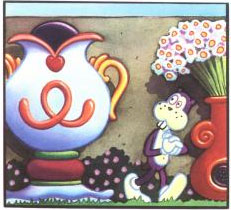
Peter Huestis: I want to discuss Frank. You told me earlier that you regard yourself as Frank's guardian. Could you elaborate on that?
Jim Woodring: I have such a sense of protectiveness towards Frank that I feel it's necessary for me to shield him from as much as I can. As he moves through the world I make things happen to him, and I have to be careful of the way I treat him. But beyond that I feel that he is such a citizen of the cosmos that I can't own him, and I couldn't sell him. He's not simply mine to do what I want with. I have an obligation to protect him.
PH: An intriguing aspect of Frank's design is that there's a tension between his "cartoony" and realistic features. His teeth, for instance, are often quite detailed, whereas the rest of his features are very generalized.
JW: There are times in comics when I like to get specific and portray something with a kind of unpleasant, clinical precision, for effect.
PH: You really played that up in the Frank cover for the first volume of Jim, where a pencil is lifting his lip up, revealing detailed dentition.
JW: Right. When I drew that I hadn't any idea that I would make him a regular cartoon character. I had the idea for him as an emblem, not a character. But when I needed a character, there he was.
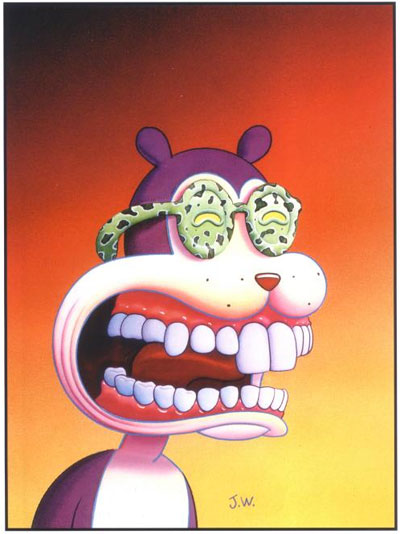
PH: Many of your stories are based on dreams. Are there certain dreams that become Frank stories?
JW: No. I never use any of my dreams in the Frank stories. I've evolved a way of writing those stories that I adhere to pretty much all the time. I go down into this ravine near my house and hide in the bushes and write in my notebook. I write the stories out in words. I'll write an opening line like, "Frank has a heavy heart." If I like that for an opener, I will ask why he has a heavy heart. Sometimes I get an answer and sometimes I don't. Sometimes an answer comes and it doesn't make any sense, like "Frank has a heavy heart because fire has burned up his landscape," and nothing else comes, so I just have to drop it. But eventually the whole story comes to light, like pulling a necklace out of the mud. I have a sense of trying to capture it as it comes by, or shine a light on it as it slithers by, more than writing it. I fish for ideas and then I test them against my... uh, whatever critical faculty I use for this stuff. If they work out, I just put 'em together and don't worry about what kind of sense it makes.
PH: But Frank does seem to inhabit a fairly consistent universe with its own internal logic. How would you describe Frank's world?
JW: Frank's home is basically the world as I saw it when I was a kid, and as I still believe it to be, which is a living, charged-up field of states where everything has meaning. It's really the main character in the stories. Frank himself is not that interesting. Frank and Manhog and all the others exist to describe the nature of that place.
PH: Frank's actions appear to be primarily motivated by curiosity. Would you agree to that?
JW: Yeah. Frank is innocent, but he's also ignoble, like a child. He's curious, but he's also motivated by self interest. He's innocent but not divine.
PH: What else motivates Frank?
JW: Desire for harmony, desire to find out about himself and the universe around him. Desire to enjoy life.
PH: Manhog, on the other hand, also seems to be driven mainly by curiosity, but of a more greedy, envious nature.
JW: Right. Manhog is composed of negative personality traits. He's greedy and cowardly, and he's got no dignity whatsoever. One of the important issues about Frank is that he doesn't really have any visible source of support. He lives in his house, and he's evidently incapable of making a living. There's really a sense that he's been provided for... that a house has been given to him, that food is given to him, and that he's led into certain circumstances which are intended to educate him. Manhog is the same way: he's plainly a charity case, too. He can do nothing for himself. They just live in this landscape which manipulates them, which is basically the way I see life. I'm really dismayed at how little control we have over our own lives, and that's the central issue here.
PH: Frank and Manhog's relationship isn't entirely antagonistic. What can you tell me about their relationship?
JW: It's symbiotic. I think they're both such pure beings that you're unlikely to encounter anyone like them in the here-and-now. They represent two sides of a whole. I know when I think of Manhog as my father, upon whom I based him, I see myself as Frank in that relationship. But when I think of Frank as being like my son, I see myself as Manhog. What they are has less to do with personality than with state.
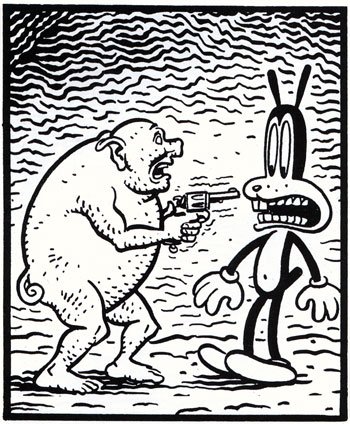
PH: How would you describe the difference between personality and state?
JW: Childhood and adulthood are different states; you and I have different personalities.
PH: Another interesting contrast between Frank and Manhog is that Frank comes across as a humanized animal, whereas Manhog comes across as an animalized human.
JW: I hadn't thought of that, but that's exactly correct. I like animals a lot; I think they're more attractive than humans in a lot of ways. What's good about Frank is what's good about a contented animal. What's bad about Manhog is what's bad about mankind.
PH: There are several other recurring characters in Frank's world. First of all, there's... I believe his name is Pupshaw?
JW: Yeah. Her, actually – it's a female. She was in a abusive relationship with one of the Jerry Chickens, which has given her a peppery attitude. She is, on the one hand, like Frank's dog: She's completely loyal to him, and he can abuse her out of frustration and she'll always adhere to him. On the other hand, she's also one of his prime protectors and guardians. She's much more powerful, and much more attuned to the tough world than Frank is. She makes herself subservient to him.
PH: Frank found Pupshaw at a yard sale run by a strange, pyramid-shaped chicken ["Frank acquires Pupshaw"].
JW: Yeah. That's one of the Jerry Chickens, the one that had the abusive relationship with Pupshaw. There's four of them. I've only shown three, but there's four.
PH: Tell me more about the Jerry Chickens.
JW: They're just chickens that have very simple geometric shapes. There's a cone, a cylinder, a sphere and a cube, and they live together in a house that looks like those individual coffee decanters they bring you in restaurants. They're all kind of rough-and-tumble sorts... soldiers of fortune.
PH: How about the long-faced man?
JW: That's Lucky. He's a human being who is being forced to live there as a punishment. I'm not sure what he's doing there, but he's not like the others. His face has been distorted to further punish him, and to prevent him from talking.
PH: And how about that bird character with the sharp beak?
JW: That's just a scary bird.
PH: One character who made an appearance in Tantalizing Stories #5 suddenly becomes very significant in the new Jim Vol. 2 #3 ["Frank's Faux Pa"]. I'm talking about the crescent-headed man.
JW: Right. He's had a few names. First I called him Scratch, and then I called him Bandini for a while, and now I'm gonna call him Whim, because he's a cold-blooded opportunist. He's the political creature among them. He wants power.
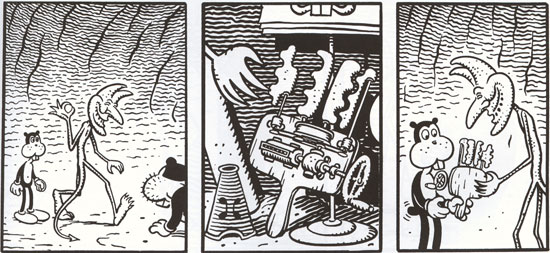
PH: Some of the most pervasive characters in the Frank stories, and also the most enigmatic, are the spindle-shaped objects.
JW: Those are Jivas, conditioned souls.
PH: There are a lot of them in Frank's world.
JW: Yes, there's lots of them... a lot of ghosts. To my way of thinking, there's a lot of them everywhere. Frank can see them and ride on them, and so forth.
PH: In "Frank and the Truth about Plenitude," in Tantalizing Stories #6, Frank hitches a ride on a Jiva and goes to a sort of temple on a mountain. He ties down the Jiva, goes inside, and looks at some portraits...
JW: They frustrate him. That place that he goes to is some human being's getaway, and someone has stashed some Dutch paintings there. Frank goes there, and he's attracted to the paintings, and he puts on the accouterments... he tries to dress like the people in the paintings, and he has a glimpse of what it's like to be human, but it's just a glimpse. He feels so powerful on this delusionary wave that he tries to grab the stars out of the sky, but he can't do it, and that frustrates him so much that he abandons the idea of being a human being entirely, and he throws all the human trappings into the water. But then he sees that there's something in the lake that's lighting the whole lake up. He jumps into the water, and the light is flashing off and on, and as he's swimming toards it, he sees that it's like a bomb that never stops exploding. So, even though it's dangerous and volatile, and always blowing up, he can get near it, and as he does, he sees an elementary radially-symmetrical life form. It's a medusae. That provides him with the answer that he's looking for, as far as his relation to the human goes. He realizes that he's been greedy in his spiritual aspirations, and has been misbehaving in enslaving this Jiva. So he liberates the Jiva, and goes back to appreciating the paintings for what they are, as opposed to allowing himself to become jealous.
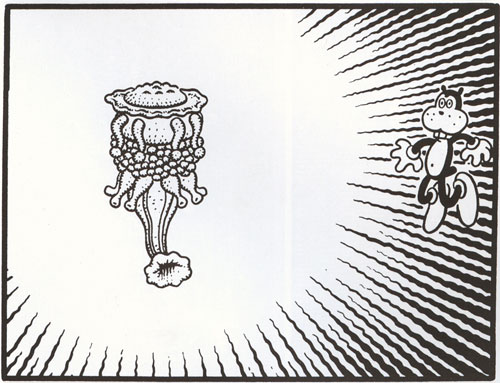
PH: There are many jars in Frank's world.
JW: Yeah, well, they're just containers to hold things. Frank's world is very materialistic, and most of the catalysts that one comes across are objects, and they need to be contained and they need to be hidden, so there's lots of jars around.
PH: I'd also like to ask about the architecture of Frank's world.
JW: I like emotional, devotional architecture where the shapes and proportions seem to reflect the personality of the cosmos. I know nothing about architecture, but it seems to me that there is a strange anthropomorphism in Moorish architecture, where human states are symbolically represented in abstract ways that need no interpretation. I'm trying to do something similar in my groping clumsy way.
PH: In the latest Jim, the color Frank story ["Authorized Only"] leaves the reader in a lurch because it's "to be continued." It also leaves the reader a little concerned for Frank's well-being.
JW: That's almost dishonest on my part, because I'm not sure that strip will be continued. If it is, Frank is lifted out of the place where he is and replaced back where he ought to be, and his shape is restored.
[Note: in later reprintings, the "to be continued" text is removed.]
PH: So Frank has trespassed...
JW: Correct. He rode on the back of a Jiva, and he sneaked into a place where he did not belong.
PH: How about the other Frank story in the same issue in which Frank and Manhog procure food ["Frank and Why it's Good to be Clever"]?
JW: I just wanted to show in that story that Manhog doesn't stand a chance in hell of ever having a normal or happy life. He's mostly ineducable, but the story showed him actually learning how to get a piece of fruit out of its shell. The first chance he has the opportunity to put that into effect, he picks up what is not a fruit, but an animal. And so, his newly-learned skills work against him, and it rouses this animal's ire, and it punishes Manhog. There a page in that story that's flopped.
PH: On the fourth page of the story. It only breaks down at the bottom, though.
JW: It kinda impedes the flow of the story.
[Note: this has been corrected in subsequent reprintings.]
PH: I guess that's the hazard of the wordless Frank stories. Speaking of which, in Jim v.1 #1, you did one with text underneath the drawings ["Manhog Beyond the Face"], and judging from your letters page, it irked some of your readers.
JW: Some people didn't like it. The reason I did it was because I had done those pages for another magazine with differently proportioned pages. When I ended up running them in Jim instead, I had a lot of dead space either at the top or the bottom. So I just ran the words there to fill up the space.
PH: I enjoyed the writing because it had a Highlights for Children feel to it.
JW: [laughs] That's exactly what I wanted!
PH: Until, well... why don't you tell the story?
JW: Manhog receives such a wallop to the head that he's not in his right mind. Inspired by a fragment of a sports trophy, he carves all the skin off one of his legs and paints the exposed muscles with silver paint.
PH: At which point the narrator...
JW: Just looks away. He's turned his head and is looking out the window. The reason I did that is because I had become acutely aware, through dealing with my son, that adults have one view of the world, and they tell children that the world is something else. So when I was writing this dialog... It's a pretty horrible story, but it's couched in very positive terms: "Oh, Manhog sees the little bird. Oh look! He threw a rock!" What's happening is terrible, but it's candy-coated in the text. When it reaches the point where there's no nice way to say, "Oh, he's butchering himself," the narration simply breaks down and starts talking about something else. I was thinking of the way we lie to children, and then shut up when there's no way of lying, or we avoid a point when there's no way of addressing it.
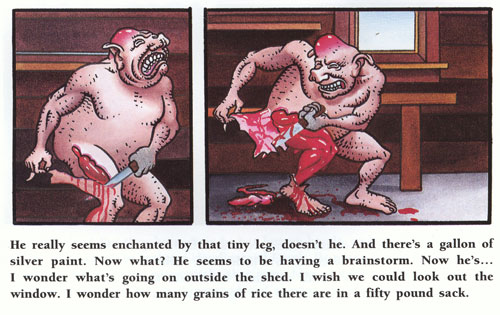
PH: What are your feelings about doing strips in color as opposed to black and white?
JW: I prefer the color stories because they can have much more emotional and psychological depth than the black and white ones, but I'm seldom happy with the way they reproduce. On the other had I have a much greater romantic attachment to pen and ink than to watercolor, because of the pen's traditional use in cartooning and because it is such a difficult medium to master.
PH: I love the blue line you use around Frank's features. You told me before that it lends Frank calmness.
JW: I wanted him to be pretty. I wanted to have to self-color, as they call it in animation, because I thought it would link the characters to the background in a nice way, and it offers yet more ways of expressing emotion. But yeah, I wanted Frank's colors to be cool and calm and harmonious. He's also purple and white, which is the most ugly color combination in the world, and my high school colors.
PH: I just remembered another object: In Jim v.2 #2, Frank visits the House of The Dead and encounters a rattle-like object with a face painted on it.
JW: Right. Those are actually offered for sale in the current issue of Jim. I'm selling them now.
PH: What can you tell me about this object?
JW: Well, you got it right – it's a rattle-like object, but it doesn't rattle, and you make it peer around corners. That's its function. The purpose is to upset people. It's best if you can do it a lot before they see it. The thing is to be peeping and looking at people for a long time without them seeing it; then when they do see it, at least in theory, it will get under their skin a lot more. The point: to give anybody who has it the power of taking on the aspects of a silent mocker, which can be hard in everyday life.
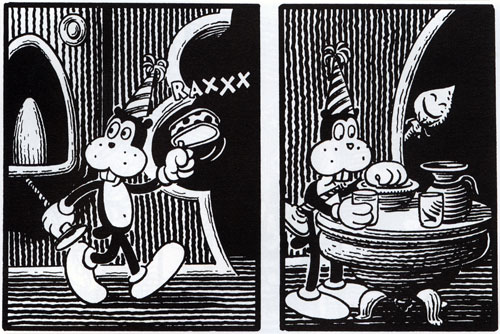
PH: How do you feel about all these stories being collected in a all-Frank book?
JW: Oh, I'm all for it. It's hard for me to look at my stuff because when I pore through it, all I see is a collection of mistakes. But I'm really happy that it's going to come out as a book. In fact, I just oversaw the last bit of it as it was going off to the printers today, and I'm real happy with it. The cover has some computer modeling done by Mark Landman, and one particular thing he did is my favorite color object I've ever seen anywhere. It's this one border around a picture in the middle of the book. It has the most perfectly beautiful combination of colors I think I've ever seen.
PH: I was surprised that you had someone else color your latest Frank story. What led you to having Mark color it?
JW: For one thing, my color work is tricky to reproduce, and I knew that by having Mark computer color that story, I would be able to predetermine the way the color would come out. In the story in Jim v.2 #1 where Manhog skins his leg, the colors shifted so radically from the original, and not in a good way. There's a body of water near the end, and in the original art it was blue/green, a real aquamarine. The way it came out printed it looks like a pool table. It destroyed the emotional impact of it. It doesn't look like he's diving into a pool of nice, cool water, but like he's diving into a pool of opaque green paint. That kind of stuff really upsets me, when the emotional content is affected. I also wanted to work with Mark because he's the best guy I know out there doing what he does, and I wanted to have him do it because I wanted to find out more about computers. I'm really, really happy with the work he did.
PH: What do you have in store for Frank next?
JW: The next issue of Jim is going to be all Frank, and then there's a long, long story in the next Whole Earth Millennium Catalog ["Frank's Real Pa"], then the collected Frank, and then Kitchen Sink Press is doing a Frank Christmas card. I'm also working on an interactive CD-ROM for a megaconglomerate in New York, which will have Frank-like aspects to it.
PH: Is this a Jim Woodring CD-ROM?
JW: No, it's a normal commercial project; I'm just designing the look of some parts of it. If it goes, it could be something really nice.
PH: And I have to ask: does it bother you that this whole interview has been about Frank?
JW: No, I love Frank. I love to think about him and talk about him. Nothing I do gives me more pleasure and satisfaction. My life would be poorer if he hadn't come along. What's strange is that so many people assume he is a cat. Take him detail by detail and he is unlike a cat in almost every particular. He looks much more like a beaver, but nobody ever suggests that. It's weird.
Jim's work is certainly easier to find than it was when I conducted this interview. Several volumes of the collected Frank stories are available from Fantagraphics and elsewhere, as well as his well-received recent graphic novel, Weathercraft. Many more wonders to behold can be viewed on Jim's website and blog. Get into Jim Woodring!
Related: Interviews with Dan Clowes and Chris Ware.
1 comment:
I love that he can come out with these really destinctive figures of speech -- "like pulling a necklace out of the mud" "shine a light on it as it slithers by" "like a bomb that never stops exploding". I love Frank, and I love Jim Woodring.
Thanks for posting this Peter!
Post a Comment